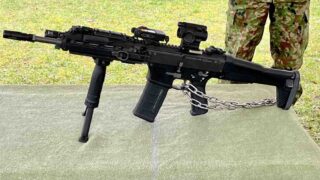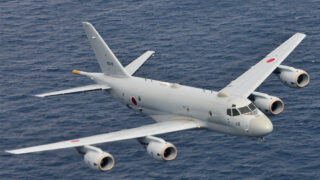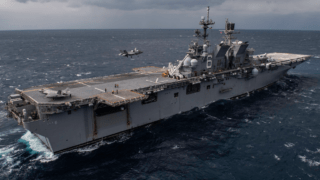HQ Facilities & Replenishment
Japan once had its shipping lanes completely destroyed by Allied submarines and sea-mines, leading to the Maritime Self-Defense Force (JMSDF) to place significant emphasis on mine clearance capabilities.
The JMSDF mine warfare unit comprises of around twenty minesweepers as well as two mine countermeasures vessels or MCMVs.
So, what is the difference between these two types of ships?
Whereas minesweepers are small vessels tasked with the actual removal of mines, the Uraga-class MCMVs are large motherships that commands the minesweepers as well as providing logistical support.
It is noteworthy that Japan is the only country with a MCMV at such scale.
- General Overview
| Displacement | 5,650 tons (standard) |
| Length | 141m (462.5ft) |
| Beam | 22m (72ft) |
| Crew | 160 people |
| Speed | 22 knots (40.7km/h, 25.3mph) |
| Armament | 76mm Naval Gun 12.7mm Machine Gun |
| Unit Cost | 300 million USD |
One of the most notable features of the Uraga-class is its ability to lay mines instead of removing them. Contrary to the minesweepers, these vessels are able to deploy up to 230 mines from their stern, making it useful in defending crucial chokepoints or restricting the enemy’s navigation.
Additionally, the mine-laying capabilities are used for deploying mock-up versions for training purposes.
Despite being classified as a “mine countermeasure” vessel, the Uraga-class lacks minesweeping capacities, since its primary role is to command and support minesweepers and helicopters.
Therefore, apart from the 12.7mm machine gun and a 76mm gun (only on Bungo), the ships are equipped with any weapons.
Mothership Capabilities
As the flagship of the mine warfare fleet, the Uraga-class is equipped with command facilities, medical facilities including an operating room, and decompression chambers for the divers who work underwater.
To support the small minesweepers, the mothership has ample space for storing supplies, as well as large baths, dining halls, and a small shop, providing a welcome respite towards the crew.
These facilities are also instrumental during disaster relief operations, with the Uraga-class being used for transporting supplies, providing bathing facilities and serving hot meals for evacuees.
Interestingly, the mine storage areas can be converted into comfortable shelters thanks to having a sophisticated temperature controlling system to preserve mines.
As such, the Uraga-class has proved to be useful in many situations, but there seems to be no plans for building a successor.
Given the severe lack of sailors and the introduction of the Mogami-class frigates, which has lay mine-laying capabilities, the likelihood of constructing a new MCMV is quite low.
In fact, the JMSDF intends to downsize its minesweeping fleet by integrating the Mogami-class frigates, resulting in the reduction of vessels dedicated purely towards mine warfare.




















Comments